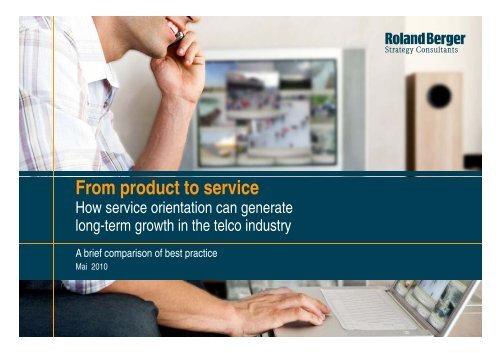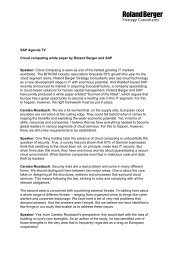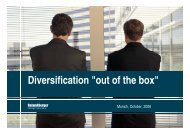From product to service - Roland Berger
From product to service - Roland Berger
From product to service - Roland Berger
Create successful ePaper yourself
Turn your PDF publications into a flip-book with our unique Google optimized e-Paper software.
<strong>From</strong> <strong>product</strong> <strong>to</strong> <strong>service</strong><br />
How <strong>service</strong> orientation can generate<br />
long-term growth in the telco industry<br />
A brief comparison of best practice<br />
Mai 2010
Executive Summary (1/3)<br />
> Telecommunication <strong>service</strong>s are undifferentiated and commoditized, competition is<br />
fierce, ,pressure on margins high, ,growth in established markets negative<br />
> Incumbent opera<strong>to</strong>rs are desperately trying <strong>to</strong> differentiate through better <strong>service</strong>,<br />
challengers through price; the impact of new <strong>product</strong>s and <strong>service</strong>s on the <strong>to</strong>p line is<br />
not visible<br />
> With the ever evolving technology and new and more complex <strong>product</strong>s, incumbent<br />
opera<strong>to</strong>rs have potentially a powerful asset they can leverage: their technical field<br />
<strong>service</strong> organization and capabilities<br />
> Companies in similar circumstances, e.g. computer or telecoms HW (like IBM, HP,<br />
Dell, Ericsson etc.) or printing (Xerox etc.) have demonstrated, that <strong>service</strong> can be an<br />
attractive "second leg" <strong>to</strong> stand on providing growth and better margins<br />
> In order <strong>to</strong> establish a <strong>service</strong> revenue stream in its own right, i.e. not as an addendum<br />
<strong>to</strong> a <strong>product</strong>, it is important <strong>to</strong> provide the right platform from which <strong>to</strong> grow<br />
Outlook from <strong>product</strong> <strong>to</strong> <strong>service</strong> excellence in telecoms_final_020610.pptx<br />
2
Executive Summary (2/3)<br />
> This means a dedicated unit, focusing on developing the <strong>service</strong> business, having full<br />
control over its entire value chain, freedom and leeway <strong>to</strong> develop its business, full<br />
management attention and support in doing so<br />
> The following pages describe some of these examples and draw conclusions and<br />
lessons learnt for the telecoms industry<br />
> IBM<br />
– In anticipation of a shift from hardware and software spending <strong>to</strong> technical<br />
<strong>service</strong>s by their corporate cus<strong>to</strong>mers, IBM announced an aggressive move away<br />
from its traditional hardware business and in<strong>to</strong> <strong>service</strong>s in the mid-1990s<br />
– Selling its loss making PC unit <strong>to</strong> Lenovo in mid-2005 marked a major step in this<br />
direction as did the 2002 acquisition of the consulting business of PwC<br />
Source: Company reports, <strong>Roland</strong> <strong>Berger</strong> analysis<br />
Outlook from <strong>product</strong> <strong>to</strong> <strong>service</strong> excellence in telecoms_final_020610.pptx<br />
3
Executive Summary (3/3)<br />
> HP and Dell followed along a similar path with their acquisitions of EDS and Perot<br />
Systems in 2008, respectively<br />
> Ericsson's Global Services Business Unit, the market leader, accounts for approx.<br />
38% of <strong>to</strong>tal revenues for the Group<br />
> Nokia Siemens Networks and Alcatel Lucent are pursuing a similar strategy as are<br />
ZTE and Huawei from China<br />
> In becoming <strong>service</strong> providers, telecom-equipment equipment makers are taking a page out of<br />
the handbook of technology companies such as IBM and HP<br />
> "The way the telecom-equipment business is changing g is very similar <strong>to</strong> the way the<br />
information-technology sec<strong>to</strong>r changed," says Andy Williams, who heads Alcatel-<br />
Lucent's <strong>service</strong> business after spending many years at IBM. "We're just about five <strong>to</strong><br />
eight years behind" the information tech industry.<br />
Source: Company reports, <strong>Roland</strong> <strong>Berger</strong> analysis<br />
Outlook from <strong>product</strong> <strong>to</strong> <strong>service</strong> excellence in telecoms_final_020610.pptx<br />
4
Delivering good <strong>service</strong>s as part of a core <strong>product</strong> offering does not<br />
suffice as a stand alone differentia<strong>to</strong>r in highly competitive markets<br />
The notion of excellent <strong>service</strong><br />
Product-based <strong>service</strong>s: <strong>service</strong>s as part of core offering<br />
Services defining business models: a new growth paradigm<br />
Service<br />
1<br />
…<br />
Service<br />
2<br />
Product<br />
Service<br />
5<br />
Service<br />
3<br />
Service<br />
4<br />
"Enhancing cus<strong>to</strong>mer<br />
experience by superior<br />
<strong>service</strong> support of <strong>product</strong><br />
usage"<br />
Product<br />
1<br />
…<br />
Product<br />
2<br />
Product<br />
3<br />
Service<br />
Service<br />
1<br />
Service<br />
2<br />
"Building sustainable and sizeable<br />
business around cus<strong>to</strong>mer <strong>service</strong><br />
offerings with <strong>product</strong>s as their<br />
elements"<br />
Key features<br />
of <strong>service</strong><br />
excellence<br />
> Cus<strong>to</strong>mer segment-based optimization i of <strong>service</strong> levels l vs. costs<br />
> Maximization of <strong>service</strong> level flexibility<br />
– Internalization of <strong>service</strong> level hygiene fac<strong>to</strong>rs<br />
– Delivery of standard cost-effective <strong>service</strong>s <strong>to</strong> low-value cus<strong>to</strong>mers<br />
– Ability <strong>to</strong> offer maximum <strong>service</strong> <strong>to</strong> <strong>to</strong>p-value segments and/or <strong>to</strong><br />
price it <strong>to</strong> broader cus<strong>to</strong>mer groups<br />
> Ud Understanding di of cus<strong>to</strong>mer base and company-related ltd cus<strong>to</strong>mer activities tiiti<br />
as the key asset<br />
> Services define new business opportunities and are a key dimension of<br />
strategic growth on corporate level<br />
> Ability <strong>to</strong> acknowledge and monetize company-related cus<strong>to</strong>mer activities<br />
> Ability <strong>to</strong> develop elop a sizeable new <strong>service</strong>s business diversifying ing from<br />
saturated and commoditized <strong>product</strong> markets<br />
Core <strong>product</strong>/<strong>product</strong>-<strong>service</strong> offering markets increasingly<br />
become commoditized – excellent <strong>service</strong> as supplement not<br />
enough <strong>to</strong> grow and retain profit<br />
Business development based on new <strong>service</strong>s is the definitive<br />
measure of <strong>service</strong> excellence<br />
Focus of this discussion paper<br />
Source: <strong>Roland</strong> <strong>Berger</strong><br />
Outlook from <strong>product</strong> <strong>to</strong> <strong>service</strong> excellence in telecoms_final_020610.pptx<br />
5
There has been a clear course of how companies moved <strong>to</strong> the <strong>service</strong>oriented<br />
paradigm driven by declining core revenues and margins<br />
The shift <strong>to</strong>wards growth through <strong>service</strong>s: market prerequisites and development path<br />
<strong>to</strong>wards success s<strong>to</strong>ries<br />
The market environment: what sec<strong>to</strong>rs have<br />
developed transformation cases<br />
The company: what had <strong>to</strong> be done <strong>to</strong> become a success<br />
Market<br />
saturation<br />
Increasing<br />
competition<br />
Emerging new<br />
technologies<br />
Quickly<br />
commoditizing<br />
core<br />
<strong>product</strong><br />
markets<br />
Significant<br />
company<br />
losses<br />
New<br />
strategic<br />
choice oceis a<br />
matter of<br />
survival<br />
Find opportunities<br />
> Explore <strong>product</strong>-related and<br />
adjacent cus<strong>to</strong>mer activity chains<br />
> Find value gaps and develop<br />
offerings, closing them and/or<br />
redistributing value contribution<br />
between company and cus<strong>to</strong>mer<br />
> Evaluate options and formulate<br />
overarching "growth through<br />
<strong>service</strong>s" strategy<br />
Internalize new strategy<br />
> Inven<strong>to</strong>ry cus<strong>to</strong>mer-related assets<br />
and capabilities and reorganize<br />
<strong>to</strong>wards new <strong>service</strong> strategy<br />
> Develop new skillset (above all,<br />
<strong>service</strong> innovation and delivery,<br />
people and reward management)<br />
> Ensure shift from <strong>product</strong>-centric <strong>to</strong><br />
<strong>service</strong> culture<br />
> Acquire and develop partner<br />
ecosystems <strong>to</strong> ensure fast scaling<br />
> Being a high-risk strategic move, growth through <strong>service</strong>s has<br />
been more focused in sec<strong>to</strong>rs where companies suffered<br />
particularly high commoditization losses – with very clear<br />
business case vs. status quo<br />
– Engineered <strong>product</strong>s and high-tech – former hardware<br />
producers, OEMs, etc.<br />
> As with any bold strategic move, success required innovation and execution – particular<br />
challenges due <strong>to</strong> significantly different cultural and competence imperatives of a<br />
<strong>service</strong>s-centric company<br />
Source: <strong>Roland</strong> <strong>Berger</strong> project experience<br />
Outlook from <strong>product</strong> <strong>to</strong> <strong>service</strong> excellence in telecoms_final_020610.pptx<br />
6
Telcos need <strong>to</strong> learn from other industry best practices <strong>to</strong> gain a<br />
competitive edge in and expand beyond their core markets<br />
Growth through <strong>service</strong> success s<strong>to</strong>ries, situation in telecoms and key questions<br />
Strategic growth through <strong>service</strong>: success s<strong>to</strong>ries<br />
> An increasing number of companies have redefined<br />
themselves and significantly outperformed the markets by<br />
growth through <strong>service</strong>s<br />
Relevance <strong>to</strong> telecoms: the current situation<br />
> Not yet feeling as heavy a press on margins, telecoms are only<br />
starting <strong>to</strong> develop <strong>service</strong>-oriented business models beyond<br />
their traditional offering<br />
3<br />
What is the agenda<br />
for telcos <strong>to</strong>wards<br />
differentiation via<br />
<strong>service</strong><br />
> To date, the definitive sizeable <strong>service</strong>-centric<br />
model pursued by telecoms best practices is IT<br />
solutions and <strong>service</strong>s for large corporates (e.g.,<br />
BT, T-Systems, Orange/Equant, AT&T)<br />
> Growth through <strong>service</strong> in other segments is in<br />
the experimental 'piloting' stage – telecoms are<br />
much slower-paced than their Internet/IT/IS rivals<br />
1 How have these companies who really achieved<br />
2 How can telcos better differentiate themselves via<br />
exceptional growth through <strong>service</strong> reorientation<br />
<strong>service</strong>s using the cross-industry best-practice<br />
empowered and reorganized themselves <strong>to</strong>wards<br />
experience<br />
this goal<br />
Source: <strong>Roland</strong> <strong>Berger</strong><br />
Outlook from <strong>product</strong> <strong>to</strong> <strong>service</strong> excellence in telecoms_final_020610.pptx<br />
7
1<br />
Previously <strong>product</strong>-focused companies have used different<br />
strategies <strong>to</strong> succeed in a <strong>service</strong>-driven environment<br />
Overview expansion in<strong>to</strong> new cus<strong>to</strong>mer activity chains (schematic)<br />
Selective successful <strong>service</strong> transformation cases<br />
Service transformation: overall description<br />
Cus<strong>to</strong>mer activities (e.g. "The purchase decision")<br />
A<br />
Capturing new cus<strong>to</strong>mer activity/creating new cus<strong>to</strong>mer activity within core activity chain by <strong>service</strong>s<br />
New<br />
A<br />
B<br />
I<br />
II<br />
III<br />
> Took over network design, deployment and maintenance activities from<br />
clients by offering these <strong>service</strong>s as well as network consulting<br />
> Developed in<strong>to</strong> facility management <strong>service</strong>s provider from its painting<br />
<strong>product</strong> expertise<br />
B<br />
Moving on from core <strong>product</strong>-based solutions <strong>to</strong>wards extended portfolio of professional <strong>service</strong>s<br />
Old<br />
C<br />
IV<br />
V<br />
VI<br />
> First developed a comprehensive technical <strong>service</strong>s and IT integration<br />
portfolio, then moving on <strong>to</strong> BPO <strong>service</strong>s ("On Demand Enterprise",<br />
"Agile Business")<br />
> Moved from traditional parcel <strong>service</strong>s <strong>to</strong> <strong>to</strong>tal supply chain solutions<br />
Old<br />
New<br />
Cus<strong>to</strong>mer chains hi (e.g. "Home purchase")<br />
C<br />
VII<br />
Rolling out successful <strong>service</strong> transformation experience <strong>to</strong> new business units/cus<strong>to</strong>mer groups<br />
> I.a. transferred successful medical <strong>service</strong>s business model <strong>to</strong> other<br />
industries (e.g. aviation, power systems)<br />
Source: <strong>Roland</strong> <strong>Berger</strong><br />
Outlook from <strong>product</strong> <strong>to</strong> <strong>service</strong> excellence in telecoms_final_020610.pptx<br />
8
2<br />
Three key learnings can be derived from successful cases of<br />
transformation <strong>to</strong>wards growth through <strong>service</strong>s<br />
Organizing <strong>to</strong>wards growth through <strong>service</strong>s: overview of key learnings<br />
A Buiding up from solid<br />
B Setting up organization:<br />
C<br />
Ramp up: developing<br />
competences and assets<br />
<strong>service</strong>s as separate units<br />
necessary skills and scale<br />
> Successful new <strong>service</strong>s did not begin with<br />
entering completely new turf<br />
> Companies started developing <strong>service</strong>-centric<br />
business models by extending relationship<br />
with existing cus<strong>to</strong>mer base leveraging<br />
– Superior cus<strong>to</strong>mer knowledge as key<br />
asset<br />
– Cus<strong>to</strong>mer proximity and delivery<br />
competence<br />
> New <strong>service</strong>s have been developed in separate<br />
organizations for a number of reasons<br />
– Developing distinctive growth-and <strong>service</strong>oriented<br />
culture<br />
– Creating possibility for <strong>product</strong> neutrality<br />
> Services set-up either as front-line or as<br />
innovation and delivery-focused organizations<br />
> Often separate ´talent pools´, e.g. professional<br />
<strong>service</strong>s, units created within <strong>service</strong><br />
organizations<br />
> New <strong>service</strong>-specific processes required, above<br />
all, <strong>service</strong> innovations process <strong>to</strong> ensure fast<br />
scalability of process and time-<strong>to</strong>-market<br />
t kt<br />
> Extensive partnering and M&A activity <strong>to</strong> rapidly<br />
achieve scale and make <strong>service</strong>s a sizeable<br />
business – with inevitable integration problems<br />
and risks<br />
IBM GS initially iti developed d from<br />
Overall setup identical in most cases,<br />
Service innovation process for<br />
hardware after-sales <strong>service</strong> units<br />
setup within <strong>service</strong> organizations<br />
scaling <strong>service</strong> offering <strong>to</strong> a<br />
can have specifics<br />
broad array of cus<strong>to</strong>mers<br />
UPS developed from several<br />
<strong>product</strong>-based <strong>service</strong> units via<br />
Numerous acquisitions with<br />
subsequent acquisitions in<br />
variing degree of success<br />
various regions<br />
…<br />
Source: <strong>Roland</strong> <strong>Berger</strong><br />
Outlook from <strong>product</strong> <strong>to</strong> <strong>service</strong> excellence in telecoms_final_020610.pptx<br />
9
2 A<br />
Successful new <strong>service</strong>s did not begin with entering completely new<br />
turf, but depend on owning their own <strong>service</strong>s value chain completely<br />
Building up from solid competences and assets: selected examples<br />
Evolution <strong>to</strong> Global Services<br />
Evolution <strong>to</strong> Total Supply Chain Solutions<br />
> Accumulated <strong>service</strong> expertise within <strong>product</strong> units via > Standalone development of small <strong>service</strong> operations<br />
operating large government IT systems<br />
within the organization :<br />
– World Wide Logistics unit<br />
> Transformation from a business division in<strong>to</strong> Integrated<br />
– Service Parts Logistics<br />
Systems Solution Corporation<br />
– World Wide Dedicated Services<br />
> IBM Global Services: rapid expansion in the IT integration<br />
and consulting <strong>service</strong>s<br />
– UPS Truck Leasing<br />
– UPS Consulting<br />
> Development over existing cus<strong>to</strong>mer base in<strong>to</strong> new<br />
markets: the on-demand strategy, focusing on business<br />
process optimization and consulting<br />
> Expansion of <strong>product</strong> portfolio and consolidation of<br />
existing <strong>service</strong> resources in<strong>to</strong> UPS Supply Chain<br />
Solutions<br />
> Further <strong>service</strong> focus by organizing in<strong>to</strong> Global<br />
> Reorganization and major M&A effort (16 key acquisitions<br />
Technology Services and Global Business Services<br />
<strong>to</strong> develop scale and growth)<br />
Source: <strong>Roland</strong> <strong>Berger</strong><br />
Outlook from <strong>product</strong> <strong>to</strong> <strong>service</strong> excellence in telecoms_final_020610.pptx<br />
10
2 B<br />
IBM organizes <strong>service</strong>s as stand-alone business units; segmented<br />
front-end organization focused on sales and cus<strong>to</strong>mer relationships<br />
Setting up <strong>service</strong> organization: overview IBM GLOBAL SERVICES<br />
Overall organizational setup<br />
Service organizational structure<br />
IBM<br />
Global Technology<br />
Services<br />
Global Business<br />
Services<br />
Global<br />
Technology<br />
Services<br />
Global<br />
Business<br />
Services<br />
Integrated supply chain<br />
Software<br />
Systems<br />
and technology<br />
Global<br />
Financing<br />
Research, dev-t, and intl.<br />
property<br />
BUSINESS<br />
UNITS<br />
BACK-END<br />
SUPPORT<br />
Strategic outsourcing<br />
<strong>service</strong>s<br />
Business transformation<br />
outsourcing<br />
Integrated technology<br />
<strong>service</strong>s<br />
Maintenance<br />
Consulting and<br />
systems integration<br />
Application<br />
management <strong>service</strong>s<br />
Sales and distribution<br />
Global<br />
Industries<br />
Regions<br />
FRONT-END<br />
DELIVERY<br />
Integrated technology<br />
delivery<br />
Business process<br />
delivery<br />
> IBM organized in<strong>to</strong> 5 business units and a global delivery unit structured by segment-region principle<br />
> Ddi Dedicated tdfll fully accountable<strong>service</strong> tbl companies: Technology Service and Business Service<br />
> Service organization organized by solution type, further on breaking down by industrial segments<br />
Source: <strong>Roland</strong> <strong>Berger</strong>, IBM<br />
Outlook from <strong>product</strong> <strong>to</strong> <strong>service</strong> excellence in telecoms_final_020610.pptx<br />
11
2 B<br />
HP organized and grouped <strong>service</strong>s in<strong>to</strong> one dedicated company<br />
Setting up <strong>service</strong> organization: overview HP<br />
Overall organizational setup<br />
Service organizational structure<br />
HP<br />
Regionsegment<br />
sales<br />
Services<br />
Cus<strong>to</strong>mer support<br />
EDS<br />
integration<br />
Services<br />
Infrastructure technology<br />
outsourcing<br />
Enterprise<br />
s<strong>to</strong>rage and<br />
servers<br />
Software<br />
Personal<br />
systems<br />
group<br />
Services<br />
Imaging and<br />
printing ggroup<br />
Managed <strong>service</strong>s<br />
Application <strong>service</strong>s<br />
HP Financial<br />
Services<br />
Corporate<br />
investments<br />
HP Labs<br />
Consulting and<br />
integration<br />
Business process<br />
outsourcing<br />
Technology <strong>service</strong>s<br />
> 7 business units and a regional organizational matrix<br />
> Services centralized in<strong>to</strong> 1 business unit; major reorganization after integration of EDS<br />
> Service organization organized by solution type, further on breaking down by industrial segments<br />
Source: <strong>Roland</strong> <strong>Berger</strong>, HP<br />
Outlook from <strong>product</strong> <strong>to</strong> <strong>service</strong> excellence in telecoms_final_020610.pptx<br />
12
2 B<br />
Nokia develops its <strong>service</strong>s business in the front-end cus<strong>to</strong>mer<br />
operations unit, having consolidated it with delivery units<br />
Setting up <strong>service</strong> organization: overview NOKIA SIEMENS NETWORKS<br />
Overall organizational setup<br />
Service organizational structure<br />
Nokia Siemens<br />
Networks<br />
Cus<strong>to</strong>mer<br />
operations<br />
Software Switching Transmission<br />
Cus<strong>to</strong>mer<br />
operations<br />
Global accounts<br />
Professional<br />
<strong>service</strong>s<br />
Regional delivery<br />
Broadband<br />
Private Nets<br />
Cus<strong>to</strong>mer<br />
<strong>service</strong><br />
Consulting<br />
<strong>service</strong><br />
Program<br />
management<br />
Education<br />
Back-end<br />
Front-end<br />
> 1 cus<strong>to</strong>mer-based front-end <strong>service</strong> unit with all the <strong>service</strong>s consolidated – from maintenance <strong>to</strong> consulting<br />
> Within thecus<strong>to</strong>mert operations unit delivery is organized dbycus<strong>to</strong>mer groups (lbl (global accountsand regional cus<strong>to</strong>mers), dedicateddi d<br />
Professional <strong>service</strong>s organization<br />
Source: <strong>Roland</strong> <strong>Berger</strong>, Nokia<br />
Outlook from <strong>product</strong> <strong>to</strong> <strong>service</strong> excellence in telecoms_final_020610.pptx<br />
13
2 B<br />
Ericsson organized its <strong>service</strong>s in a dedicated business unit<br />
performing cus<strong>to</strong>mer relationships via separate entities<br />
Setting up <strong>service</strong> organization: overview ERICSSON<br />
Overall organizational setup<br />
Service organizational structure<br />
Ericsson<br />
BU Global<br />
<strong>service</strong>s<br />
BU<br />
Multimedia<br />
BU Global<br />
Services<br />
BU CDMA<br />
Mobile<br />
Systems<br />
BU<br />
Networks<br />
Global<br />
cus<strong>to</strong>mer<br />
accounts<br />
Cus<strong>to</strong>mer<br />
support<br />
Network rollout<br />
Consulting<br />
Research<br />
Regional<br />
market units<br />
Managed<br />
<strong>service</strong>s<br />
Systems<br />
integration<br />
Learning<br />
<strong>service</strong>s<br />
Back-end<br />
Front-end<br />
> Consolidated back-end <strong>service</strong> business unit structured by <strong>service</strong> types<br />
> Clear front-end definition fiiti for sales and cus<strong>to</strong>mer relationships based on key accountsand regions<br />
Source: <strong>Roland</strong> <strong>Berger</strong>, Ericsson<br />
Outlook from <strong>product</strong> <strong>to</strong> <strong>service</strong> excellence in telecoms_final_020610.pptx<br />
14
2 B<br />
LH Technik run in a decentralized way, with most sales and delivery<br />
capabilities down on the level of divisions/division business units<br />
Setting up <strong>service</strong> organization: overview LUFTHANSA<br />
Overall organizational setup<br />
Service organizational structure<br />
CEO Lufthansa<br />
German Airlines<br />
Lufthansa<br />
Group<br />
Chief Officer Group<br />
Airlines, HR<br />
Chief Financial<br />
Officer<br />
Lufthansa<br />
Technik<br />
Production and<br />
development<br />
HR&Corporate, incl.<br />
marketing&sales<br />
Corporate functions<br />
Lufthansa<br />
Passenger Airlines<br />
Swiss<br />
Austrian<br />
Airlines<br />
bmi<br />
Brussels<br />
Airlines<br />
Aircraft<br />
mainte-<br />
nance<br />
Germanwings<br />
Sunexpress<br />
Lufthansa<br />
Cargo<br />
Lufthansa<br />
Systems<br />
Lufthansa<br />
Technik<br />
LSG Sky<br />
Chefs<br />
Service and<br />
Financial<br />
Companies<br />
Component<br />
support<br />
Engines<br />
Aircraft<br />
overhaul<br />
Landing<br />
Gear<br />
VIP &<br />
Executive<br />
e<br />
Jet<br />
> Largely au<strong>to</strong>nomous <strong>product</strong> divisions with full spectrum of front- and back-end functions<br />
(incl. <strong>product</strong> development, finance and controlling, marketing and sales, etc.)<br />
Product/<strong>service</strong> divisions<br />
> LH Technik runs 31 maintenance opera<strong>to</strong>rs and has stakes in 55 companies – active<br />
M&A´s across all <strong>product</strong> and <strong>service</strong> lines<br />
Group companies<br />
> Dedicated technical <strong>service</strong> group of companies established in 1994 <strong>to</strong> further diversify Group's business in the competitive markets<br />
> Service organization marked by rapid growth of business and constant M&A activity – organizational consolidation perceived as a<br />
staged effort, with many divisions/daughter companies still functioning in an au<strong>to</strong>nomous way<br />
Source: <strong>Roland</strong> <strong>Berger</strong>, LH<br />
Outlook from <strong>product</strong> <strong>to</strong> <strong>service</strong> excellence in telecoms_final_020610.pptx<br />
15
2 C<br />
Successful growth through <strong>service</strong> requires a robust <strong>service</strong> innovations<br />
process for quick scaling and control of the value delivery chain<br />
Service innovations process: example IBM<br />
Front end… Integrative ti leadership… Back end… Front end…<br />
Creates one-off solution<br />
for single cus<strong>to</strong>mer<br />
Identifies solution as<br />
scaling candidate<br />
Codifies and<br />
standardizes<br />
Delivers a solution platform<br />
<strong>to</strong> many cus<strong>to</strong>mers<br />
DEVELOPMENT<br />
STEP<br />
> Cooperation with<br />
> Designates successful<br />
> Develops integrated t e-<br />
> Rolls out solution across<br />
cutting-edge banking one-off solution as commerce banking Europe, following<br />
cus<strong>to</strong>mer in<br />
priority for leveraging; industry solution that is observed patterns of<br />
Scandinavia on e- forms team and adaptable <strong>to</strong> individual innovation adoption in<br />
commerce solution provides resources bank needs banking industry<br />
ORGANIZATIONAL<br />
LEAD<br />
Global industries<br />
Financial <strong>service</strong>s<br />
industry segment<br />
Originating<br />
cus<strong>to</strong>mer account<br />
team<br />
Cross-unit geographic<br />
leadership team for<br />
Europe, Middle East and<br />
Africa<br />
Global <strong>service</strong>s<br />
Cross-unit team<br />
including hardware,<br />
software, <strong>service</strong>s,<br />
and financial<br />
<strong>service</strong>s units<br />
Global industries<br />
Financial <strong>service</strong>s<br />
industry segment<br />
Disseminating<br />
cus<strong>to</strong>mer account<br />
teams<br />
Source: IBM, <strong>Roland</strong> <strong>Berger</strong> project experience<br />
Outlook from <strong>product</strong> <strong>to</strong> <strong>service</strong> excellence in telecoms_final_020610.pptx<br />
16
Telcos pursue growth through <strong>service</strong>s only in the large corporates<br />
segment – <strong>service</strong> differentiation in mass segments the next step<br />
Organizing growth for new <strong>service</strong>s by telcos: overview<br />
Product vs. <strong>service</strong> orientation in key telcos'<br />
business segments<br />
Service transformation: overall description<br />
CUSTOMER SEGMENTS<br />
Multinatio-nals<br />
Corporates<br />
SME/SOHO<br />
Residential<br />
Products<br />
A<br />
B<br />
<br />
–<br />
Services<br />
BUSINESS FOCUS<br />
A<br />
B<br />
<br />
Development of separate communications and IT solutions and outsourcing businesses for the<br />
global market of large corporate clients<br />
> Best-in-class telcos have reorganized <strong>to</strong>wards dedicated solutions businesses for large corporates – BT Global<br />
Services, T-Systems, Orange Business Services, Verizon Business, AT&T widely cited as most successful<br />
cases<br />
> Development of <strong>service</strong> business for large corporates even in case of telcos proves the case – dedicated<br />
<strong>service</strong>s organizations necessary, on <strong>to</strong>p of existing corporate clients business units – as hubs of <strong>service</strong> culture,<br />
innovation and integrated delivery<br />
Growing through <strong>service</strong>s in mass (residential and business) markets<br />
> Telco's are only starting <strong>to</strong> explore the potential in the mass segments - on the one hand there is<br />
more complexity of scaling/rolling out <strong>service</strong>s <strong>to</strong> mass markets; however, many enabling technologies<br />
are already in place<br />
> Two major areas pursued as of <strong>to</strong>day:<br />
Experiments with ih new <strong>service</strong> business models via M&A's or separate incubation i (strategic/equity<br />
i<br />
participation with limited integration in<strong>to</strong> core business) - e.g. acquisition of Terra Networks by Telefonica,<br />
partial separation of <strong>service</strong> areas in<strong>to</strong> new companies and acquisitions by Swisscom (Alphapay, Cablex,<br />
acquisitions of CoComment, Evita, etc.)<br />
– Development of partner ecosystems <strong>to</strong> get more presence in communication based <strong>service</strong>s (content, e-<br />
commerce, IP communications etc.)<br />
Local efforts may be not enough <strong>to</strong> make a meaningful business out of <strong>service</strong>s for mass<br />
markets – rethinking overall strategy and organization necessary<br />
Source: <strong>Roland</strong> <strong>Berger</strong><br />
Outlook from <strong>product</strong> <strong>to</strong> <strong>service</strong> excellence in telecoms_final_020610.pptx<br />
17
Although still rare, successful cases of growing through <strong>service</strong>s in<br />
telecom mass segments are starting <strong>to</strong> appear<br />
Successful <strong>service</strong>-centric business models in telecoms: case Relacom<br />
Background<br />
Business model overview<br />
Nt Network<br />
<strong>service</strong>s units<br />
Network<br />
<strong>service</strong>s units<br />
Telavie<br />
Flextronics<br />
Network <strong>service</strong>s<br />
Orbiant Group<br />
1. Spin-off of major 2. Acquisition by Swedish<br />
telcos' network private equity fund Al<strong>to</strong>r<br />
<strong>service</strong>s units and merger<br />
Independent provider of network <strong>service</strong>s <strong>to</strong> opera<strong>to</strong>rs, corporate and<br />
residential clients<br />
> Clients: Fixed and mobile<br />
opera<strong>to</strong>rs, network equipment<br />
producers<br />
> Services:<br />
– Construction: project management,<br />
site management,<br />
design and technical planning<br />
of networks<br />
– Installation: network construc-<br />
tion, hardware Installation, start<br />
of operation<br />
– Maintenance: administration,<br />
repairs, optimization<br />
> Clients: Business clients from<br />
telecoms and other industries<br />
(e.g. Volvo)<br />
> Services:<br />
– Telephony: Operating fixed<br />
and mobile applica<strong>to</strong>ins of<br />
clients<br />
– IT, networks and security:<br />
operating of network<br />
infrastructure, administration<br />
and optimization<br />
> Clients: Private clients<br />
> Services:<br />
– Installation: field<br />
installation of<br />
broadband and<br />
telephony<br />
– Maintenance: cus<strong>to</strong>mer<br />
care in case of ne<strong>to</strong>wkr<br />
problems<br />
> Although currently primarily concentrated on working with telecoms opera<strong>to</strong>rs, Relacom was one of the first <strong>to</strong> apply the <strong>service</strong>-oriented<br />
business model <strong>to</strong> mass segments<br />
> An extremely high-growth company <strong>to</strong> date: since its foundation in 1998, Relacoms revenues grew from EUR 5 m <strong>to</strong> > EUR 1 bn in 2008<br />
Source: Company sources, <strong>Roland</strong> <strong>Berger</strong><br />
Outlook from <strong>product</strong> <strong>to</strong> <strong>service</strong> excellence in telecoms_final_020610.pptx<br />
18
Telcos, therefore, should consider growing through <strong>service</strong>s via a<br />
focused effort on corporate level<br />
Organizing growth for new <strong>service</strong>s by telcos: overview<br />
> In order <strong>to</strong> leverage further strategic growth opportunities, telcos should consider an option<br />
of developing a dedicated <strong>service</strong> organization (company), which has control of its entire<br />
value chain, primarily focusing on multi<strong>product</strong> communications <strong>service</strong>s for mass segments<br />
> Successful <strong>service</strong> companies do not start this from scratch – these <strong>service</strong> organizations<br />
should be built up on the basis of existing units/companies and businesses with the bestsuited<br />
set of <strong>service</strong> assets and capabilities<br />
– Cus<strong>to</strong>mer knowledge<br />
– Service development, standardization and roll-out capabilities<br />
– Complete <strong>service</strong> delivery<br />
> The primary focus of new <strong>service</strong> organizations should be <strong>service</strong> innovation excellence and<br />
ability <strong>to</strong> scale cus<strong>to</strong>mer solutions, rapid growth orientation and PMI capability, excellence in<br />
<strong>service</strong> delivery<br />
> Cus<strong>to</strong>mer front-end responsibility (marketing and sales) should be placed in<strong>to</strong> new <strong>service</strong><br />
organization<br />
Outlook from <strong>product</strong> <strong>to</strong> <strong>service</strong> excellence in telecoms_final_020610.pptx<br />
19

















